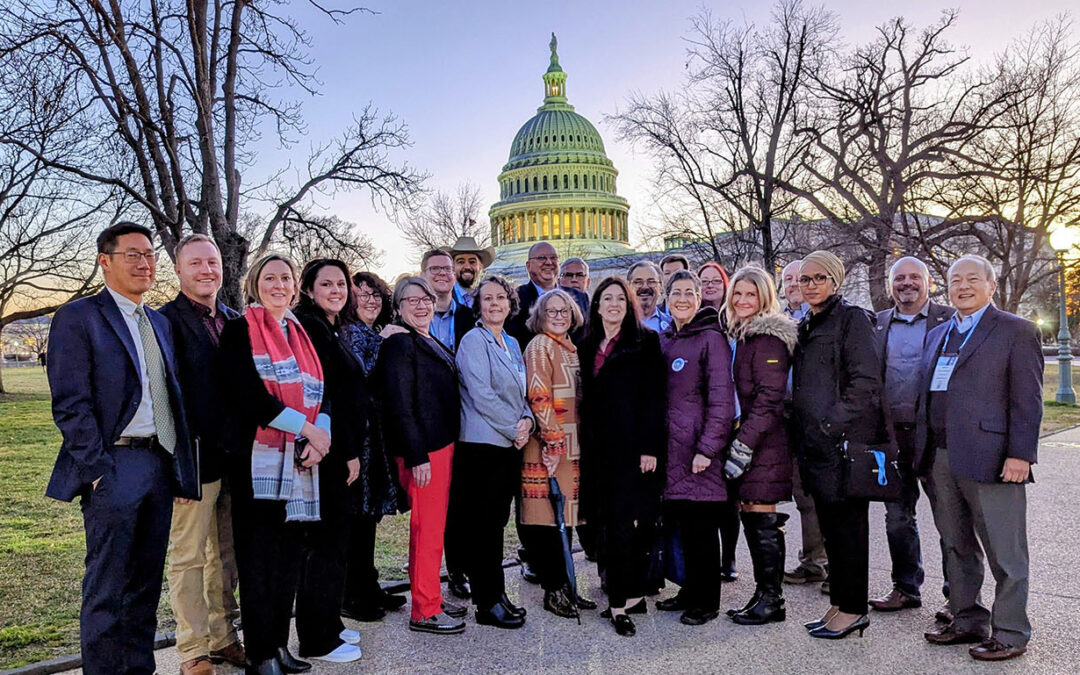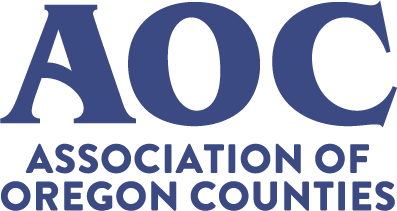
Feb 28, 2023 | NACo
Thirty-seven Oregon county commissioners, judges, chairs, and staff traveled to Washington, D.C. to participate in the 2023 National Association of Counties (NACo) Legislative Conference, held February 11-14.
County officials also met with Oregon Senators Ron Wyden and Jeff Merkley to advocate for Association of Oregon Counties (AOC) federal policy priorities.
First-time attendee, Polk County Commissioner Jeremy Gordon commented, “It was powerful to join my AOC colleagues to speak with Senators Wyden and Merkley with one voice around our shared needs for behavioral health crisis services, housing, flexible transportation funding, and sustained SRS funding.”
During the conference, the Oregon delegation engaged in NACo policy discussions through NACo’s policy steering committee process, as well as breakout sessions, and general sessions, hearing from a range of speakers in the federal government, including President Joe Biden, U.S. Secretary of the Treasury Janet Yellen, U.S. Transportation Secretary Pete Buttigieg; U.S. Secretary of Agriculture Tom Vilsack, U.S. Department of Health and Human Services Secretary Xavier Becerra, and administration staff.
“Learning the ways we can leverage this time of historic investment to help our communities is motivating. Figuring out how to navigate the federal funding streams provides an abundance of opportunities,” said Klamath County Commissioner Kelley Minty of the programming and resources provided during the conference.
The conference offers not only policy discussions, but a platform for connecting with commissioners across the United States. “I was able to learn about commonalities and the innovative ways federal programs are implemented in other communities, and through the Human Services and Education Steering Committee, I was able to give voice to the mental health struggles Polk County youth and adults are experiencing and ways we can better align the intentions of federal programs with my community’s needs,” said Gordon.
AOC Executive Director Gina Firman Nikkel added, “The conference is a key point for our commissioners to network together, get to know each other, build trust, and meet commissioners from other counties to work on key issues that are important to them.”
NACo steering committees tackled a number of issues relevant for counties across the U.S. and took positions on policies that would inform NACo’s work among federal agencies, Congress, and the White House on issues ranging from wildfire, to health care, to broadband, among others.
The work addressed in the steering committees unite counties across the United States in their advocacy efforts at the national level. Tillamook County Commissioner David Yamamoto agreed, “The issues that we face in individual counties across Oregon and all across Oregon are the same issues that you find across the nation.”
Notably, during the final day of the conference, NACo announced the appointment of AOC Executive Director Gina Firman Nikkel, Ph.D. to the newly created NACo Mental Health and Wellbeing Commission. The commission will work to drive change in the nation’s mental health system and policies.
“Participating in NACo is one of the best things you can do not only for your professional development, but you bring new and innovative ideas back to your county,” said Clackamas County Commissioner Martha Schrader, who chairs the NACo Community, Economic, and Workforce Development Steering Committee. She urged county officials to engage in their national association.
County officials across Oregon found meaning in the program content, as well as the networking opportunities. “The great thing about NACo is the comradery,” said Yamamoto.
Proposed NACo Interim Policy Resolutions can be found here.
AOC federal priorities can be found here.
Contributed by: Megan Chuinard | Public Affairs Associate

Feb 27, 2023 | NACo
On Feb. 21, the U.S. Department of the Treasury (Treasury) resumed operations of its Office of Recovery Programs Contact Center which provides technical assistance to recipients of American Rescue Plan Act (ARPA) funds administered by Treasury. This includes the State and Local Fiscal Recovery Fund (Recovery Fund), the Local Assistance and Tribal Consistency Fund (LATCF), and the Emergency Rental Assistance (ERA) program. Treasury alerted county recipients to the Contact Center’s reopening on Feb. 14, stating that:
“The Contact Center closed last year due to an administrative funding shortfall, which impacted Treasury’s ability to provide support to recipients of funding from the Office of Recovery Programs. However, late last year Congress provided additional resources for the Office of Recovery Programs in the Consolidated Appropriations Act, 2023. As a result, Treasury is able to reopen the Contact Center in order to better support recipients by answering their phone and email inquiries.”
Since the bill’s initial introduction in Oct. 2021, the National Association of Counties (NACo) has advocated for the passage of the State, Local, Tribal, and Territorial Fiscal Recovery, Infrastructure, and Disaster Relief Flexibility Act to provide counties with the flexibility to invest funds in transportation infrastructure, Community Development Block Grant (CDBG)-eligible and natural disaster related projects. The bill was ultimately passed as an amendment to the Fiscal Year 2023 omnibus appropriations bill (Consolidated Appropriation Act of 2023) in Dec. 2022. In addition to the expanded flexibilities, the bill also unlocked unobligated administrative funds for the Office of Recovery Programs that has allowed Treasury to reopen this contact center. Treasury is expected to release additional guidance for the bill’s expanded eligible uses in the coming month. NACo will alert counties when this guidance is available.
Since ARPA was enacted in March 2021, counties have been working tirelessly with Treasury to ensure Recovery Funds have the flexibility to properly address our unique needs and that we are fulfilling our role as sound financial stewards. Treasury has been a critical partner and valuable resource throughout the implementation of the Recovery Fund and with the recent release of LATCF payments, this partnership is as critical as ever.
NACo also has several resources available to counties to assist with the continued implementation and investment of the Recovery Fund and LATCF. Counties may ask questions regarding ARPA recovery funds here and NACo staff will respond via email.
Contributed by: Maxx Silvan | NACo

Feb 24, 2023 | AOC Business Partner
At the beginning of every year, the CIS Board of Trustees, including AOC Executive Director Gina Firman Nikkel, attend a day and a half strategic planning session to discuss the overall strength of the organization. The board reviews the status of CIS’ strategic initiatives and is presented with professional analysis from independent industry experts who assess the health and strength of CIS. Highlights from the board’s most recent session include:
- Financial Audit Presentation by Plante Moran, PLLC
- Property/Casualty (P/C) Trust Actuarial presentation by Aon Risk Consultants, Inc.
- Capital Adequacy Assessment for CIS Benefits and P/C Trust by PricewaterhouseCoopers (PwC)
- CIS Collaboration Center Update
- Managing the Risks of Post-Traumatic Stress Disorder (PTSD) in Public Safety
- Reinsurance Markets and Planning
Financial Audit
Plante Moran, one of the nation’s largest accounting firms, verified CIS’ good standing and strong financial footing — giving the organization a clean audit. The firm shared with the board that CIS’ accounting principles are solid (see full audit on CIS’ website). The audit report did provide an overview of the investment losses that CIS faced with the decreased market value from bonds and stocks in 2022 — but CIS weathered these adjustments for unrealized market value changes and maintained extremely solid financials. They concluded that CIS’ finances are appropriately reported, and the organization’s accounting systems are well-organized.
Actuarial Report
The respected actuarial firm, Aon Risk Consultants, analyzed CIS’ past experiences to evaluate the financial impact of current economic and social trends on future events. Aon’s report helps determine CIS’ funding target for the upcoming fiscal year. The actuaries noted that liabilities related to public safety services were increasingly costly to settle. They also noted an increase in auto liability claims. However, they explained that CIS’ experience with public safety services and auto liability claims followed trends that they noticed with other risk pooling programs across the nation.
PricewaterhouseCoopers Assesses CIS’ Capital Adequacy
PricewaterhouseCoopers firm (PwC) provided the CIS Board with a capital adequacy assessment for the CIS Benefits Trusts as well as the Property/Casualty (P/C) Trust during the session. They conducted a formal analysis of capital reserve funding requirements. The analysis was based on the requirements of the Member Equity Policy and considered many internal and external factors including underwriting risk, reserving risk, asset and credit risk, and operational risk.
PwC’s report found that both CIS’ capital for the Benefits Trusts as well as the P/C Trust is adequate and are in the proper range. This was important because it confirms that CIS has enough funds in reserves to cover catastrophic claims and other financial disruptions — such as the market value declines on investments.
Collaboration Center Update
The CIS Board provided direction to staff to begin plans for a new Collaboration Center to serve as an office for staff and training center for members and agents. CIS sold its Salem and Tigard office buildings, opened a temporary Wilsonville office, and purchased land in Wilsonville for a future Collaboration Center.
Plans call for a building with multiple meeting rooms, including a large room that can be used for member/agent training. Staff has selected an owner’s representative, architectural firm, and construction manager/general contractor through request for proposal (RFP) processes. CIS plans to meet with the architectural firm this quarter to kick-off the design process.
Managing the Risks of Post-Traumatic Stress Disorder (PTSD) in Public Safety
In June 2019, Senate Bill 507 passed, making PTSD a presumption for public safety workers (i.e., full-time firefighters, police officers, corrections officers, parole/probation officers, and first responders). CIS supports public safety workers having presumptive claims. CIS’ public safety team is working proactively to prevent PTSD claims by:
- Providing critical incident grants to public safety personnel and in some cases, non-public safety, to receive mental health services that have a focus on PTSD.
- Providing training around PTSD via Employee Assistance Program (EAP), peer support, and total worker health.
- Developing mental health providers around the state that have a focus on PTSD in public safety or military.
- Including CIS Benefits Director Mike Beyrouty to find ways for the CIS Benefits programs to support PTSD-prevention efforts.
The purpose of the report was to begin CIS Board discussions on additional services that can help reduce the impact of PTSD.
Reinsurance Markets and Planning
CIS purchases reinsurance to protect the P/C Trust from catastrophic and high dollar claims.
For property, CIS self-insures the first $500,000 of each claim and offers $600 million of shared limits. For liability, CIS self-insures the first $1 million per claim but offers liability coverage up to $20 million. For cyber, CIS self-insures the first $250,000 of each claim and offers an optional reinsured tier of coverage with limits up to $1.25 million.
Reinsurance coverage cycles between soft and hard markets. Experts point to missed earnings targets in recent years as evidence that the industry is in a hard market. This means reinsurers have greater bargaining power and can push for higher premiums and restructure terms to their advantage, such as limiting coverage for certain risks or demanding higher retentions (deductibles).
CIS marketed reinsurance coverage to dozens of carriers during 2022 to maintain the best carriers, pricing, and terms to financially back its property and liability programs. Marketing efforts included strengthening partnerships with existing carriers and identifying new carriers to diversify risks and increase capacity.
In this tough environment, CIS’ efforts to build and strengthen its reinsurance partnerships means that they can retain the needed reinsurance despite a hard market.
Contributed by: Bill LaMarche | CIS Public and Member Relations Manager
*Sponsored content provided by AOC Business Partner.

Feb 24, 2023 | AOC Business Partner
At the recent Academy of Architecture for Justice Conference, I had the opportunity to facilitate discussion on equity in the justice system. These discussions focused on knowledge communities in education, social services, nonprofit organization and justice agencies couples with resources, and evidence-based support systems needed to create a healthy society.
The Challenges: We know that healthy family relationships have a positive impact on the incarcerated, their children, and their loved ones. Strong relationships can improve the cause-and-effect cycle of recidivism and reduce the social, economic, educational, and health consequences to those within the secure treatment environment. These relationships, however, often face barriers by the very facilities built to house them. For instance, programs that encourage incarcerated mothers to record themselves reading storybooks to their children often must resort to a noisy corridor due to lack of dedicated private space. Other facilities may lack accessible and welcoming visitation rooms to connect families. Organizations who dedicate time to engaging at-risk youth lack flexible and comfortable spaces to bring education to their communities. These are the sorts of challenges that community partners face in their work and yet, they are often not at the table when it comes time to plan facilities.
The Opportunities: Working together with our government agency clients, we’re bringing more stakeholder voices to the table, working with our clients to find creative ways to integrate community partners into the big picture of justice facility designs. When we couple our design knowledge and the agency needs with the offerings of community partners, we all help to restore individuals back to their families and communities. Together we’re preparing spaces for a more equitable, healing, and transformative environment for individuals and the communities where they live. We design this way because we always remember that the incarcerated are individuals with children, partners, and dreams of once again making a positive impact on society.
The opportunities abound that can make a difference in how we deliver services and resources that positively impact individuals and communities. We simply need to advocate for equity for all stakeholders in justice design.
Contributed by: Joanna Wozniak, AIA | DLR Group, Senior Associate
*Sponsored content provided by AOC Business Partner.

Feb 24, 2023 | AOC News
The March Economic and Revenue Forecast was presented during a joint meeting of the Senate Committee on Finance and Revenue and the House Committee on Revenue and House Revenue Committees on Feb. 22. The committees heard from state economists at the Office of Economic Analysis that there will be “additional resources available for policymakers” as they develop the 23-25 biennium budget. Compared to the December Economic and Revenue Forecast the projected ending balance is up $487.1 million. That said, analysts also noted there is still an amount of uncertainty, including a full tax cycle broaching in April and noted the office will be in a better position in the middle of May when they present the close-of-session forecast to understand actual receipts and available funds. The May Economic and Revenue Forecast will be used by lawmakers to develop the 23-25 biennial budget. The latest projections could help eliminate the projected $560 million shortfall predicted by analysts in December.
Corporate and personal income taxes remain strong, showing 25 percent annual growth over the past five years, far more rapid than underlying measures of profits would suggest. Analysts commented that with the improved baseline economic outlook, additional gains in most taxes are expected through the 23-25 biennium, with a notable exception in the marijuana tax, which is expected to fall by 11 percent due to low prices, reducing drug treatment funds.
New Facts
- Fourth quarter personal income tax collections came in $261.6 million (9.4 percent) above the December 2022 forecast.
- Fourth quarter corporate income tax collections came in $131.1 million (54.6 percent) above the December 2022 forecast.
- Fourth quarter state personal income was $1.1 billion (-0.4 percent) below the December 2022 forecast.
- Fourth quarter state employment was 6,655 jobs (0.3 percent) above the December 2022 forecast.
Change Since Close of Session
- Personal income tax revenue is up $3,557.4 million (17.2 percent) from the 2021 close-of-session estimate.
- Corporate tax revenue is up $1,545.5 million (115.0 percent) from the 2021 close-of-session estimate.
- General Fund gross revenue is up $5,483.6 million (23.4 percent) from the 2021 close-of-session estimate.
- Net General Fund and Lottery fund resources are up $6,653.6 million (24 percent) from the 2021 close-of-session estimate.
Kicker Funds Implied by Forecast
- Personal – A personal kicker of $3,938.2 million is projected for 2023.
- Corporate – A corporate tax revenue of $1,545.5 million is projected to be dedicated to K-12 education spending in the 23-25 biennium.
Revenue Changes
- Projected 21-23 biennium net General Fund resources are up $487.1 million (1.7 percent) from the December 2022 forecast.
- Projected 2021-23 Lottery Fund resources are up $16.4 million (0.9 percent) from the December 2022 forecast.
- Projected combined net General Fund and Lottery Fund resources are up $503.5 million (1.5 percent) from the December 2022 forecast.
Ending Balance
- The projected ending balance is up $4,065.2 million from the 2021 close-of-session estimate.
- The projected ending balance is up $487.1 million from the December 2022 forecast.
- The Rainy Day Fund is projected to receive $278.6 million following the 2021-23 biennium.
Contributed by: Anna Braun | AOC Contract Lobbyist, Government, Revenue, and Veterans





